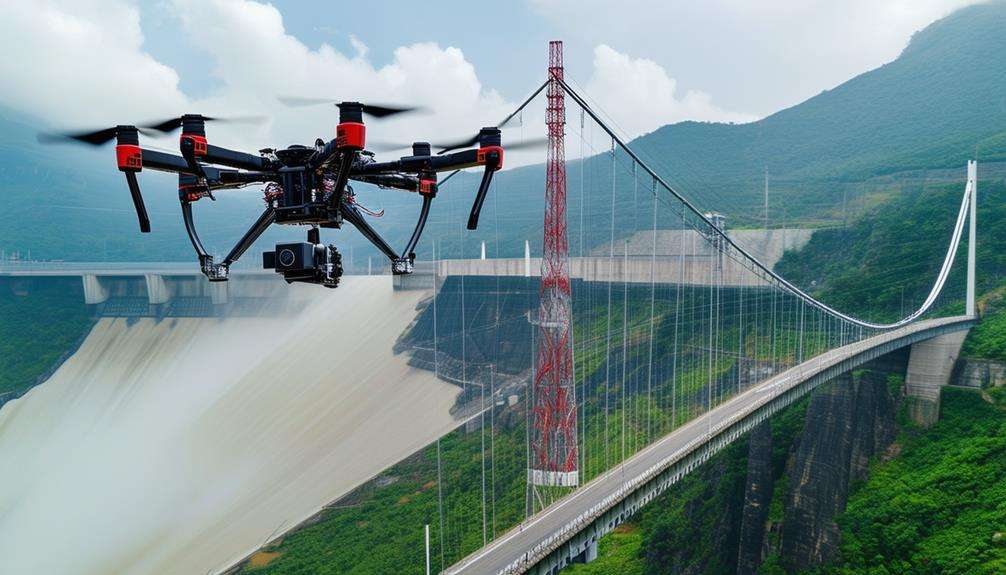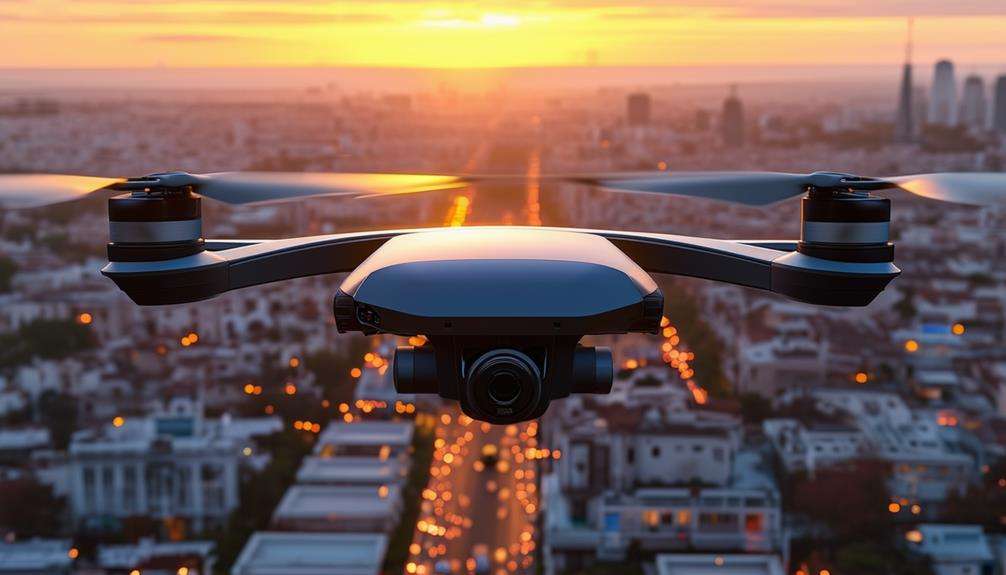The Transition From Military to Commercial Drone Applications
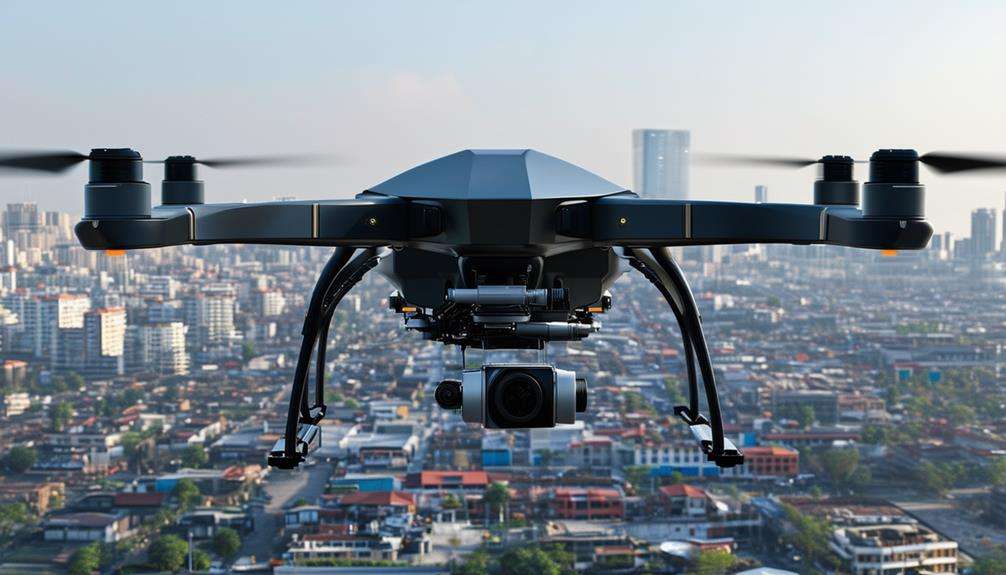
The transition from military to commercial drone applications is a remarkable evolution, with UAV technology advancing from simple radio-controlled aircraft to sophisticated systems utilized in combat.
The FAA's decision to grant permits in 2006 catalyzed a revolution across multiple industries. Drones now play a critical role in agriculture, healthcare, and news reporting, offering cost-effective solutions and boosting productivity.
The versatility of drones is just beginning to unfold, presenting new opportunities and challenges. How are these advancements shaping our world today, and what future trends might emerge from this technological evolution?
Historical Background
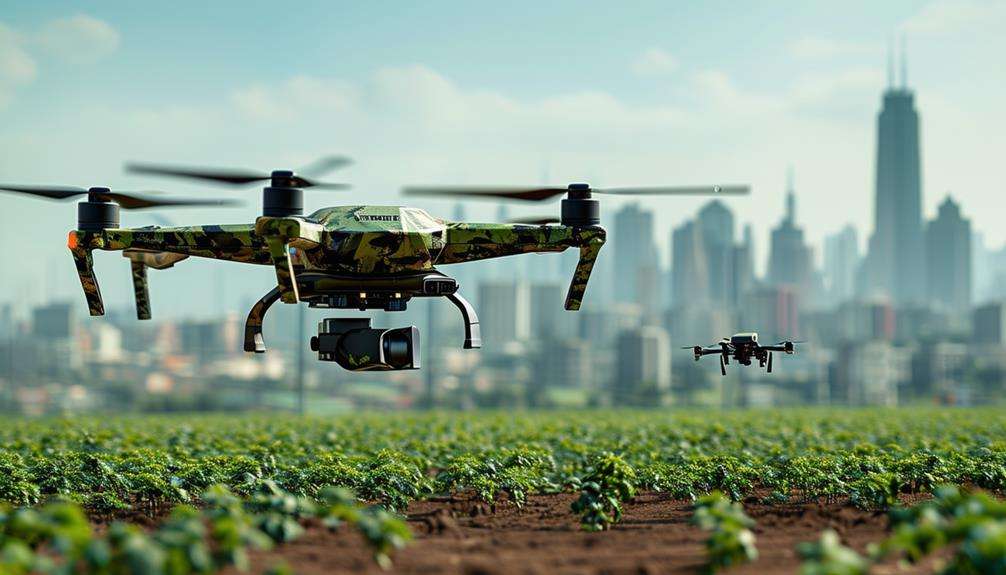
The transition from military to commercial drone applications commenced in 2006 when the FAA issued the first commercial drone permits, paving the way for businesses to explore new opportunities. This milestone marked the evolution of Unmanned Aerial Vehicles (UAVs) from exclusive military use in reconnaissance and combat missions to versatile tools for diverse commercial applications.
Industries such as agriculture, healthcare, and news reporting rapidly embraced UAVs, recognizing their potential for performing tasks that were previously deemed too hazardous or time-consuming for humans. For example, drones began to be employed for aerial crop inspections, significantly enhancing agricultural efficiency.
Furthermore, advancements in autonomous drone technology broadened the scope of commercial applications, making operations more efficient and cost-effective. This technological progression, coupled with regulatory changes, spurred the increasing demand for UAVs across various sectors, including disaster relief, delivery services, transportation, construction, and logistics.
Military Drone Evolution
Military drones have evolved significantly from their inception as radio-controlled aircraft in WWI to the advanced reconnaissance and combat UAVs of today. Early models like the Aerial Target and Queen Bee were primarily used for training purposes. However, by the 1980s, the development of remotely piloted vehicles (RPVs) marked a major technological advancement, enabling their use in intelligence, surveillance, and reconnaissance missions. These RPVs set the groundwork for the sophisticated military drones currently in use.
Modern military drones perform various critical functions, including:
- Reconnaissance: Utilizing advanced sensors and cameras to gather vital intelligence.
- Combat Operations: Executing offensive missions and targeted strikes with high precision.
- Training: Serving as aerial targets to enhance military personnel's skills.
The advancements in UAV technology have revolutionized military operations, improving operational efficiency and minimizing human risk. However, these advancements also bring significant legal, ethical, and psychological challenges.
Issues such as accountability, transparency, and susceptibility to hacking are major concerns. Additionally, the pervasive surveillance capabilities of drones raise questions about privacy and the psychological effects on those being monitored. Despite these challenges, drones remain indispensable assets in modern warfare.
Early Commercial Adoption

In 2006, the FAA's issuance of the initial commercial drone permits opened the door to a broad range of non-military applications. This marked the onset of drones being used for various commercial purposes.
Drones quickly became invaluable in disaster relief efforts, where their ability to survey damage and deliver aid proved crucial. Security companies began utilizing drones for surveillance, offering a more flexible and cost-effective solution compared to traditional methods.
The use of drones for inspections also gained popularity, especially in industries like construction and infrastructure. Inspecting hard-to-reach areas with drones not only improved safety but also saved time and resources.
Companies like Amazon started exploring commercial applications such as Prime Air, aiming to revolutionize goods delivery by making it faster and more efficient. News organizations also adopted drones to capture footage for reporting, replacing helicopters and traffic cameras, and providing expanded coverage.
The global medical drone market saw significant growth, further showcasing the expanding commercial drone industry. The early adoption phase clearly demonstrated the versatility and potential of drones across different sectors.
Environmental Applications
Drones can monitor wildlife populations, providing real-time insights without disturbing natural habitats. In agriculture, they offer precision mapping, detect crop damage, and assist in managing water drainage. These applications not only enhance efficiency but also promote sustainable practices.
Monitoring Wildlife Populations
Commercial drones are transforming wildlife monitoring by providing essential data for conservation efforts. Equipped with thermal cameras, drones can detect and track animal movements, offering insights into their behaviors without disturbing their natural habitats. This technology is crucial for collecting real-time data on the health and distribution of various species, significantly enhancing conservation strategies.
Using drones for wildlife monitoring offers several advantages:
- Non-invasive Observation: Drones can observe animals without causing stress or altering their behavior.
- Cost-Effective Solutions: Drones reduce the need for expensive manned flights and extensive ground surveys, making monitoring more accessible.
- Enhanced Anti-Poaching Efforts: Drones can quickly patrol vast areas, helping to prevent illegal hunting and poaching activities.
Drones provide a bird's-eye view of endangered species, allowing for the monitoring of their numbers and movements across large territories. Thermal cameras enhance their capability for night-time monitoring and detecting animals hidden by dense foliage. This data is invaluable for making informed decisions in wildlife conservation, ensuring that species thrive in their natural habitats. Embracing drone technology actively contributes to preserving the planet's biodiversity.
Precision Agriculture Insights
Precision agriculture drones are revolutionizing farming by delivering real-time data to optimize crop yields and resource management. Equipped with advanced sensors and AI algorithms, these drones can map regions, detect crop damage, and monitor water drainage issues, all essential for maximizing agricultural efficiency.
Imagine scanning up to 500 acres a day using LiDAR sensors on drones. This technology generates 3D point clouds, enabling precise land surveying and mapping. Such detailed insights help you identify issues like soil erosion and uneven terrain, making farm management more accurate and effective.
AI algorithms are crucial in this transformation. These systems analyze data collected by drones, identifying diseases, pests, and livestock conditions. Early detection allows for timely actions to mitigate damage and enhance crop health.
In addition, drones are expanding their roles in precision agriculture, performing tasks like insecticide spraying and irrigation. This automation boosts overall farm efficiency and productivity. Integrating AI with drone technology not only makes precision agriculture more accessible but also promotes sustainable farming practices, providing valuable insights for long-term success.
Construction and Surveying
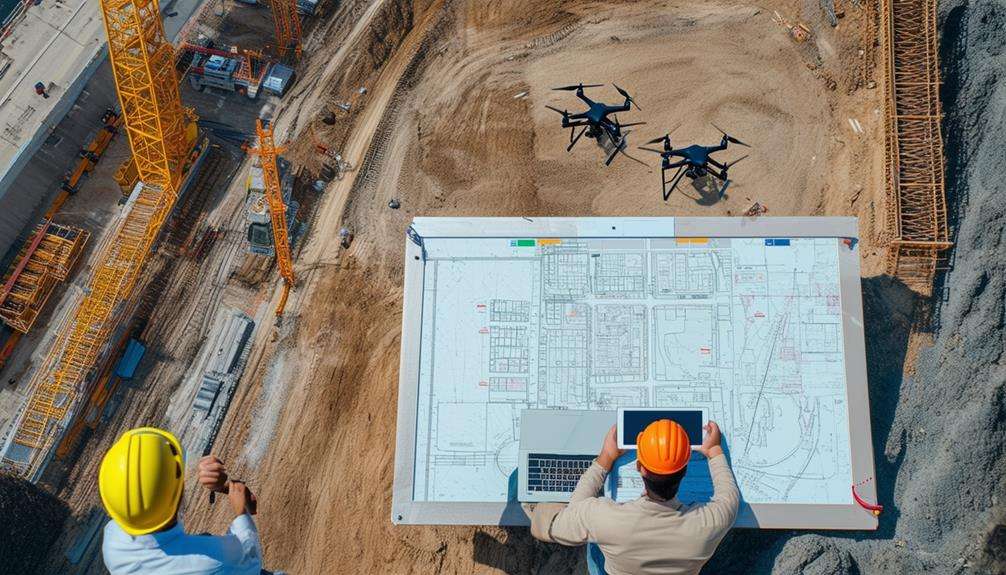
In the construction industry, drones are revolutionizing project monitoring and asset inspection in real-time. With drones, you can oversee construction sites with unparalleled accuracy and efficiency. Equipped with LiDAR technology, drones can scan up to 500 acres a day, streamlining land surveying and mapping tasks. This eliminates the need for traditional, time-consuming methods.
Drones in construction enable the creation of digital twins—virtual models of physical objects. These digital twins offer valuable insights into project progress and asset performance, allowing you to predict potential issues before they become costly problems, thereby ensuring smoother operations and better resource management.
Here are some ways drones are transforming construction and surveying:
- Real-time Monitoring: Track project progress and make timely decisions based on current data.
- Efficient Land Surveying: Use LiDAR-equipped drones to map large areas quickly, saving time and money.
- Enhanced Planning: Digital twins provide a detailed view, assisting in precise project planning and execution.
Asset Inspections
Integrating drones into asset inspections can enhance efficiency, reducing inspection times by up to 75%. These cost-effective solutions provide high-resolution images that facilitate the detection of defects and structural issues. Their use improves safety and reduces costs across various industries, including oil and gas, construction, and utilities.
Efficiency in Inspections
Drones significantly enhance the efficiency of asset inspections by capturing high-resolution images and videos, reducing inspection times by up to 75%. Utilizing drones for asset inspections not only increases operational efficiency but also ensures detailed analysis through advanced imaging technologies. Commercial drones have become essential for inspecting infrastructure such as bridges, pipelines, and buildings, enabling more precise and timely maintenance.
The advantages of using drones for asset inspections include:
- Advanced Data Collection: Equipped with sensors like LiDAR and thermal cameras, drones provide comprehensive data for thorough inspections.
- Increased Safety: Drones reduce safety risks for workers by accessing hazardous or hard-to-reach areas.
- Operational Efficiency: Quick deployment and high-quality data collection shorten inspection times, facilitating faster decision-making and action.
In commercial applications, these benefits lead to more efficient asset management and less downtime for critical infrastructure. Leveraging drone technology not only speeds up inspections but also enhances their reliability, resulting in better-maintained assets and improved overall productivity.
Cost-Effective Solutions
Utilizing commercial drones for asset inspections can cut costs by up to 50% compared to traditional methods, providing a highly cost-effective solution. Deploying drone technology for inspecting assets such as power lines, wind turbines, and infrastructure not only saves money but also conserves time and resources. These applications enable swift and accurate identification of potential issues, thereby enhancing both efficiency and accuracy.
Traditional inspection methods often entail significant downtime and safety risks. However, the adoption of commercial drone applications mitigates these drawbacks. Drones can effortlessly access hard-to-reach areas without endangering personnel, thereby significantly enhancing safety measures. This results in fewer operational interruptions and a smoother workflow overall.
Additionally, the advanced data collection capabilities of drones offer detailed, high-quality visual and thermal imagery. This enhanced data supports more informed decision-making, leading to improved maintenance and repair strategies. The cost-effective solutions provided by drone technology not only reduce expenses but also enhance operational performance.
LiDAR and 3D Mapping

Harnessing LiDAR technology for 3D mapping has revolutionized industries by delivering unprecedented accuracy and efficiency in surveying and modeling expansive areas. When LiDAR sensors are attached to drones, they measure distances, detect objects, and generate detailed 3D point clouds. Aerial LiDAR is transformative for sectors such as construction, archaeology, and mining, where precision is essential. For instance, scanning up to 500 acres in a single day, a task that would take weeks with traditional methods, is now possible.
One of the most exciting advancements is the development of digital twins—virtual models that simulate the future performance of assets. These digital twins offer a comprehensive view of projects, making it easier to visualize and plan effectively. Integrating LiDAR technology with drones simplifies this process, providing a robust tool for project management.
LiDAR-equipped drones are also invaluable in agriculture. They facilitate the mapping of regions, detection of crop damage, identification of drainage issues, monitoring of yield quantities, and even assessment of livestock health. The benefits of using them include:
- Efficiency: Rapid and accurate coverage of large areas.
- Versatility: Applicable in diverse fields like agriculture, construction, and archaeology.
- Precision: High-resolution data ensures detailed and reliable 3D models.
AI Integration
AI integration in commercial drones transforms operations by enabling autonomous decision-making and real-time data analysis. When drones are equipped with AI, they can optimize flight paths, avoid obstacles, and adapt to changing conditions, significantly enhancing efficiency. These intelligent drones are revolutionizing various sectors by executing complex tasks with high precision.
In agriculture, AI-enabled drones can analyze crop health in real-time, thereby maximizing yields. In the construction industry, they can monitor site progress and detect potential issues early. For inspection tasks, these drones autonomously recognize and assess structural damages. This integration elevates data collection and analysis, making operations more effective across different fields.
Here's a visual breakdown of AI integration impacts on drone applications:
| Feature | Impact |
|---|---|
| Autonomous Decision-Making | Optimizes flight paths and avoids obstacles |
| Real-Time Data Analysis | Enhances data collection and operational efficiency |
| Adaptability | Adjusts to changing environmental conditions |
| Precision Tasks | Executes complex tasks with high accuracy |
Industry-Specific Benefits
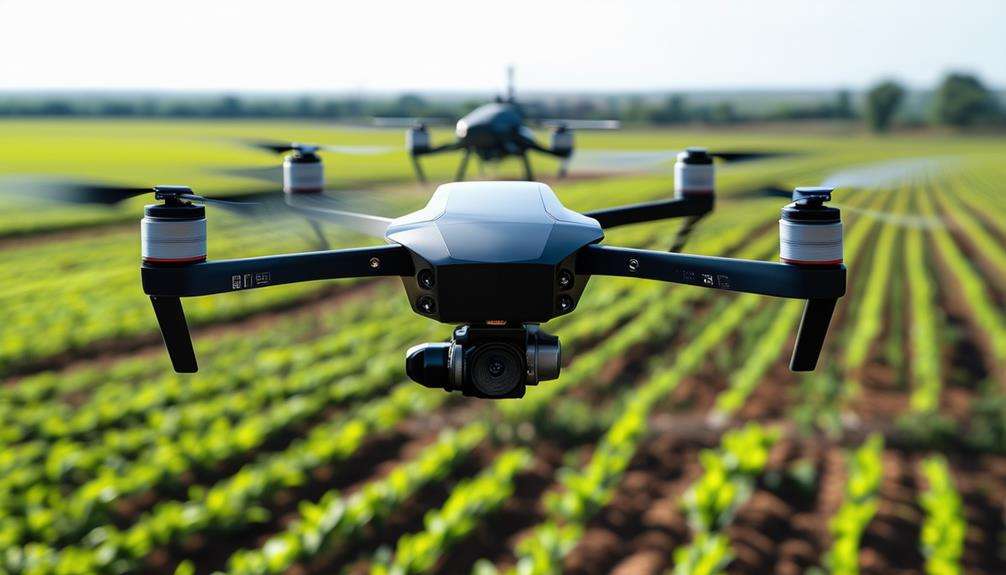
Commercial drones are transforming various industries by enabling faster deliveries, reducing costs, and enhancing operational efficiency. In the technology sector, professionals are strong advocates of commercial drone applications, recognizing their potential to revolutionize multiple operations.
Take the healthcare sector, for example. While some professionals may initially hesitate to adopt drones for medicine deliveries, they acknowledge the significant advantages drones offer in emergency response scenarios. In challenging terrains, drones can quickly assess disaster situations and provide real-time data, potentially saving lives.
News organizations are also leveraging drones to replace traditional methods like helicopters and traffic cameras. Drones offer detailed aerial views of road conditions, saving time and resources and delivering more precise information. This shift not only reduces costs but also improves the quality of news reporting.
Here are some industry-specific benefits of commercial drones:
- Faster Deliveries: Services like Amazon's Prime Air utilize drones to meet the growing demand for quick and efficient delivery solutions.
- Cost Reduction: Drone operations are often more cost-effective compared to traditional delivery systems.
- Enhanced Emergency Response: Drones improve disaster assessment and emergency response, particularly in hard-to-reach areas.
Future Trends
Looking ahead, integrating artificial intelligence with drones will revolutionize how industries process and analyze data. AI-driven drones won't only gather information but also interpret it in real-time, making operations more efficient and precise. This development is pivotal for the drone industry, as it expands the capabilities of remotely piloted aerial vehicles (UAVs) across different sectors.
This technology will transform land surveying with aerial LiDAR, enabling drones to scan up to 500 acres a day. This results in faster, more accurate mapping and data collection. In agriculture, AI-enhanced drones can monitor crop health, optimize irrigation, and even predict yields, helping farmers make informed decisions that enhance productivity.
The concept of digital twins is another exciting trend. By using drone-captured data and AI algorithms, you can create virtual replicas of physical assets. This allows for predictive maintenance and performance analysis, reducing downtime and costs in industries like manufacturing and infrastructure.
Moreover, increased accessibility to drone technology will drive broader adoption in fields like healthcare, supply chain management, and news reporting. As UAVs become more advanced and affordable, their applications will continue to grow, revolutionizing operations in ways we can only begin to imagine.
Conclusion
Drones have evolved from military tools to indispensable assets in various industries. This transformation has unlocked numerous possibilities, from environmental conservation to advanced construction surveys.
With AI integration and tailored industry applications, drones are reshaping our world. As technology advances, we can anticipate even more innovative uses, making drones a vital part of everyday life and business operations. The future of UAV technology is promising and still unfolding.

